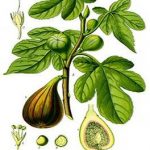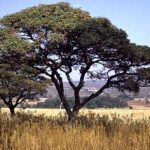TREE LIFE
January 2013
MASHONALAND CALENDAR
Tuesday January 15th: Botanic Gardens walk with Tom Muller. Meet at 4.45pm in the car park of the Botanic Gardens.
Sunday January 20: Outing to Bally Vaughan. Bring the usual equipment – a hat, sunblock, a chair and lunch. We will meet at 9:30 am.
Saturday 26 January: The Linds. By kind permission of Adrian and Odette Lind, we shall be visiting their garden in Borrowdale. They have planted a large number of indigenous trees, so there will be plenty of interest. Meeting time: 2.30 p.m.
TREE OF THE MONTH
Commiphora marlothii
Family: Burseracea – The myrrh family. Botanical names: Commiphora marlothii. Common names: Corkwood; Paperbark ; Nd: Umkwazakwaza ; Sh: Chiwirowiro.
In Zimbabwe the Burseracea are represented by a good number of Commiphora all of which I have seen: C. africana, C. angolensis, C. caerulea, C. edulis, C. glandulosa, C. karibensis C. mossambicensis, C. marlothii, C. mollis, C. pyracanthoides, C. schimperi and C. viminea.
Commiphora species are deciduous and for most of the year the trees are without leaves, making identification hazardous. However bark characteristics are often diagnostic and used to identify the trees. The bark of most species peels off in papery pieces and flakes, often with a greenish layer underneath, mostly the bark is corky but some species have variable bark.
The genus name Commiphora comes from the Greek “kommi”, meaning “gum”, and “phoros”, meaning “carrier”. The Commiphora are dioecious, i.e. there are separate male and female trees. They exude a resin that can be fragrant or have medicinal properties, the most famous being Commiphora myrrha, that originates in desert areas in the horn of Africa and produces myrrh that is used in perfumes, medicines (such as aromatic wound dressings), and in incense. In Zimbabwe most of our Commiphora species favour the drier areas but some, such as C. marlothii have a wider distribution.
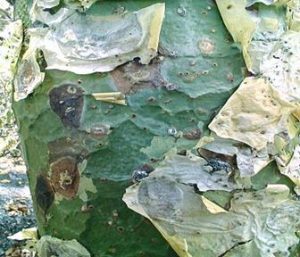
Commiphora marlothii bark
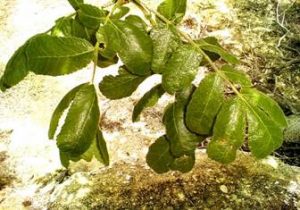
Commiphora marlothii leaves
Combretum marlothii is a small to medium sized tree with a somewhat thick trunk. The bark peels off in thin paper like patches revealing the green underbark. Identification is therefore easy and the only tree it can possibly be confused with is the Albizia tanganyicensis bark, Paperbark albizia. As both trees like rocky areas, in some places like the Matopos, you can find the two in close proximity to each other. The diagnostic feature is the very green underbark of C. marlothii.
The tree comes into leaf in October / November at the same time the flowers grow in the leaves axils. The flowers are yellowish, rather inconspicuous and in dense compact heads or racemes. The leaves are compound and imparipinnate with three to five pairs of leaflets. The fruit is a fleshy drupe, sub globose, furry and green or reddish and partly enveloped by a yellow pseudo-aril. The fruit is edible either fresh or made into jam.
The wood is light, saws and planes cleanly to a lustrous finish and is moderately durable.
The roots, scraped clean, are chewed for their sweet juice. Commiphora marlothii can be used for fencing, as the branches strike very easily the poles grow into new trees.
Outing to Hippo Pools 13th – 16th September 2012
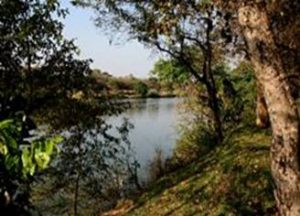
Hippo Pools
Episode 2
FRIDAY, 14 SEPTEMBER
During the morning we did two walks through the riverine forest with a break for tea in the middle. Meg Coates Palgrave and I led, with numerous contributions from the others present.
The Hippo Pools staff has done an excellent job of labelling the trees, using a circular metal disk which is stapled to the tree. On the one visible side are the English name and a tree number; if one lifts that side up, the other side may be seen which gives the Latin name.
Attached are two pictures showing an example of this for Ormocarpum kirkii.
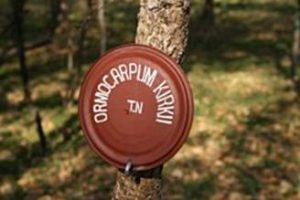
Example of the labelling at Hippo Pools
Not only have numerous trees been labelled but we also found that the labels were nearly all accurately done. Incidentally, a lot of work has also been done in creating colour-coded walks through the forest and the surrounding hinterland although on this trip we did not make very much use of them.
One word of warning: a lot of species have been planted in the riverine part which are not really native to that area. For example, there are some very fine planted specimens of Ficus lutea, Faidherbia albida and Acacia xanthophloea, and this can be misleading at times.
I should add that this account of the weekend is highly selective and merely covers a few of the most interesting things seen.
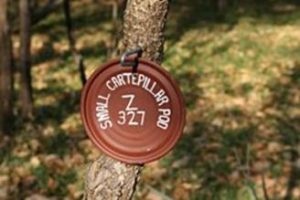
Example of labelling
I was a bit surprised to see Piliostigma thonningii, Monkey bread as such a major component of the riverine vegetation; and the books do indeed imply that this is mostly a species of deciduous woodland. However, it was extremely common here in the riverine forest. The Combretum adenogonium, Four-leaved Combretum with its leaves in whorls of 3 or 4 was, with C. microphyllum, the commonest Combretum species we saw in the riverine vegetation. It was also flowering extensively.
Holarrhena pubescens, Jasmine tree was also common in the riverine area. At this time of year it was in fruit with its distinctive long, narrow pendulous follicles. The leaves are opposite and like all Apocynaceae it has a milky sap.
A spectacular large tree in full flower was Stereospermum kunthianum, Pink jacaranda. This has a very distinctive smooth mottled bark and pink flowers which on this large specimen were too high up to reach. In the afternoon, we walked out of camp along a dried-up rocky stream bed. A most interesting find, which I had never seen before, was Garcinia livingstonei, African mangosteen in flower. The flowers are greenish-white with reflexed petals and arise in clusters on the branches. The group quickly clustered round these flowers and a lot of pictures were taken.
Nearby, climbing high in the trees, was Entada chrysostachys, Zambezi entada. This is a widespread species occurring in Zimbabwe at lower altitudes, which for some reason I have never seen before. Maybe it is widespread but not common? Possibly it’s easily overlooked. Here the fruits were visible high up, showing clearly the winged seeds borne in their ‘wire frame’. This species has yellowish spikes (the specific name refers to this) and 2-pinnate leaves with numerous small leaflets.
Along the stream (and also by the Mazowe River itself) was Ficus capreifolia River sandpaper fig with its distinctive sandpapery leaves. Kigelia africana, Sausage trees, Diospyros mespiliformis and Strychnos potatorum were also seen. One interesting creeping herb was Nelsonia canescens, which has very long-hairy leaves and a spike of blue flowers. Although the spikes were visible, unfortunately we were too late for the flowers.
In the north of Zimbabwe, we get a different species of Pterocarpus, namely P. brenanii, Eared bloodwood (referring to the very large and prominent stipules) and this is common at Hippo Pools. At this rather leafless time of the year most of the trees were only bearing the dried up fruits which are more or less flat, circular pods with a central seed.
Hippo Pools also has frequent thickets of Catunaregam taylorii. Often these are quite small plants which easily scratch one’s legs. This belongs to the family Rubiaceae (the coffee family) and is one of the few spiny species.
We emerged onto the road and where a stream bed crossed the road, we found Nuxia oppositifolia, Water elder and Mimusops zeyheri, Red milkwood both typical of such a habitat. A climbing species with leaves only was later confirmed at the herbarium as Opilia amentacea. This has rather brittle slightly fleshy leaves which are stellate-hairy, although a lens is needed to see the hairs.
In the evening. dinner was served in the open at a row of tables overlooking the Mazowe. Iain Jarvis gave us a talk about his longstanding connection with Hippo Pools and some of the events that have taken place over the years.
SATURDAY, 15 SEPTEMBER
In the morning we walked out of camp up a hill to the Hide (which overlooks a small dam) and swimming pool. This took us out of the riverine and into a completely different rocky flora.
The hill itself had some very fine Euphorbia cooperi var. cooperi, Candelabra euphorbia. These were in flower and fruit and most conveniently one flowering specimen was a short plant that was very easy to photograph. Amongst the heaped up rocks were fine very sharp-tipped leaves of a succulent Sansevieriea pearsonii.
Another very spiny Rubiaceae seen was Canthium glaucum subsp. frangula, Pink-fruit canthium. A beautiful flowering Ipomoea was seen, flowering before the leaves. This was Ipomoea shirambensis, named after Shiramba in the Lower Zambezi valley, Mozambique. Although the dam was dry, two herbaceous plants growing on the dry mud were investigated and turned out later to be Heliotropium ovalifolium and Ammannia prieuriana.
In the afternoon we walked to the weir. This was no great distance but took us all afternoon as we puzzled over the trees we came across. This stretch of the Mazowe is much more open than near the camp and might really be termed woodland rather than forest. A number of different things therefore came to light.
We found some young flowers, more buds really, of Artabotrys brachypetalus. Interestingly, some were, as I expected, borne on the strange bent hooks for which this species well known. However, others were just coming off the branch in the normal way. In the rather dry and somewhat leafless environment of mid-September, a flowering specimen of Mundulea sericea, Cork bush looked absolutely stunning. Fruiting paired pods of a climbing Apocynaceae, Taccazzea apiculata, were also found by the river. The last supper of this all-too-short trip ended with a series of appropriate gifts being given by Bill to all attending.
SUNDAY, 16 SEPTEMBER
This was our last day and people left during the morning for the 150 kms drive back to Harare. Meg, Isla and I walked out of the riverine area into the very dry deciduous miombo woodland alongside the entrance road. Little was flowering but one that we did find was a Blepharis, later identified as B. pungens. Lannea discolor was also flowering nicely. Doreen Bolnick also showed us a very interesting, as-yet-unidentified Hyacinthaceae.
SUMMARY
A great social time was had by all, apart from a couple of people who bad stomach upsets, which they seemed to have brought with them from Harare. Thanks as always to Bill and Fiona for their thorough planning, imagination and meticulous attention to detail which makes these trips such a success. I would also like to thank Meg Coates Palgrave for coming along, leading many of the walks and for freely sharing her encyclopedic knowledge of trees. Thanks also to the unflappable Iain Jarvis for his friendly assistance.
– Mark Hyde


